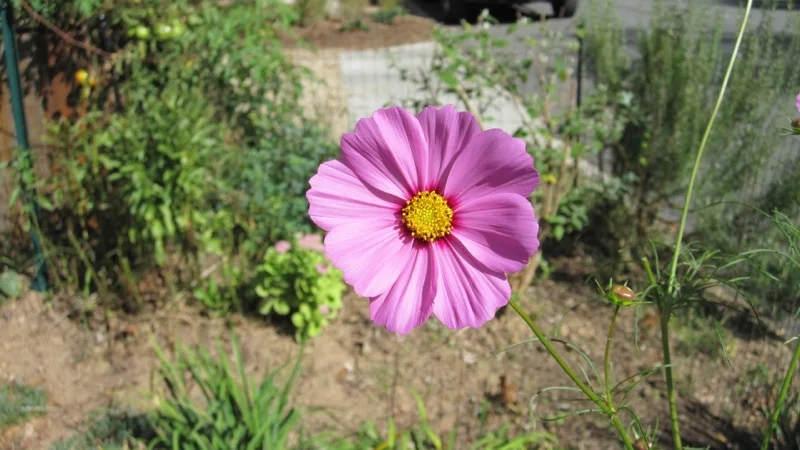The weather changed for the worse this weekend in my neck of the woods, but not before I shot some photos of the last few flowers struggling in my front yard. It later occurred to me that both of the flowers I shot had literary connections for me.
The cosmos, which displays its customary 8-petaled Fibonacci number, reminded me of an interview I conducted with organic farmer/poet Scott Chaskey some years ago when I was writing The Newman’s Own Organics Guide to a Good Life, with my co-author Nell Newman. Chaskey, who later went on to publish a charming book entitled This Common Ground: Seasons on an Organic Farm, told me then that cosmos are one of his favorite plants:
“I know they’re simple and gaudy, but I like them. Last year I planted a long hedge of them, and people would immerse themselves in these six-foot plants and come out happy.”
I myself find these plants really delicate. Every year I dream of sowing them in a thick hedge like the one Chaskey speaks of, but never manage to pull it off. I love watching them bob on their spindly necks. I can’t plant enough of them, and thankfully there are lots of different varieties.
Another Fibonacci eight-petaled flower is the dahlia, which isn’t perennial in most parts of the U.S. In colder climates like ours, if you want them to come back, you have to dig up the tubers at the end of the season and carefully preserve them indoors for planting the following season. I haven’t been able to pull that off successfully either. (Whaddaya want? I’m a writer, not a farmer.)
But I cannot look at these lush flowers without thinking of crime fiction. These days anyone who knows anything about mystery fiction has heard of the famous Black Dahlia murder, probably thanks to James Ellroy’s fictionalized version of the case, and the subsequent film based on the book. But far fewer people probably remember the 1946 film noir called The Blue Dahlia, starring Alan Ladd, Veronica Lake, and William Bendix. The film was produced by John Houseman and is best remembered as the work of Raymond Chandler, screenwriter.
Back a hundred years ago, before I knew anything of Ellroy or the gruesome murder case, I saw the Ladd-Lake-Bendix film at a library film series near where I grew up in New Jersey. The series, introduced by a local college professor who specialized in detective fiction, opened my eyes to a bunch of films that I would never have seen otherwise. I also remember thinking it was cool to have a job as a professor analyzing and writing about mysteries. Who knew that they would let you do that?
Years later, I became obsessed with Ellroy’s work after reading his Dahlia novel. I bought a bunch of his signed, first editions from The Mysterious Bookshop in New York City, and read them all in quick succession. Then, one day, I came across an article in People magazine that mentioned that this mad genius lived in a basement apartment in Easchester, New York.
Gee, I thought, that’s not far from me. I could call him and tell him how much I like his work. Or something. I wasn’t thinking too clearly on this, I have to admit, but I called information and dialed the number.
“Ellroy,” the great man answered.
I panicked, and hung up the phone.
See what beautiful memories come from a walk in the garden?
Yes, I am trying to post here more often. Thank you for noticing. If you want to sign up for my newsletter and claim your collection of free ebooks, go here. Thanks!




